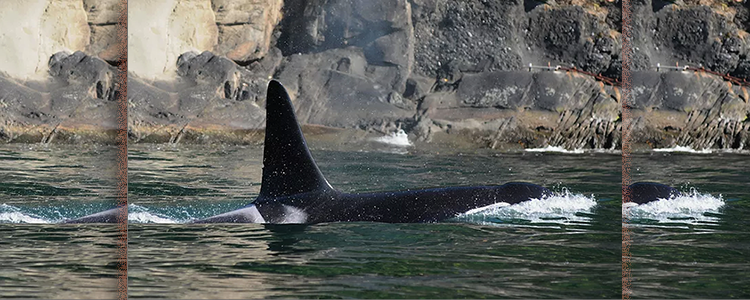||| FROM CENTER FOR WHALE RESEARCH |||
Center for Whale Research Statement:
Southern Resident killer whale K21

On July 28, the Center for Whale Research (CWR) received a report and video from a Pacific Whale Watch Association (PWWA) vessel of an apparently distressed killer whale in the Strait of Juan de Fuca. A CWR observer aboard a different PWWA vessel obtained further photographs of the whale. From these images, CWR scientists were able to confirm that the whale was 35-year-old male Southern Resident, K21, exhibiting severe emaciation and dorsal fin collapse. Members of all three Southern Resident pods, including K21’s closest associates, were photographed by CWR staff from the shore of San Juan Island on the evening of July 27; however, K21 was not located during this time.
The images from July 28 indicate that K21 would likely not survive much longer. The precise cause of his condition cannot yet be determined. Weather and border restrictions have precluded further direct observation by CWR staff. Fisheries and Oceans Canada are currently coordinating monitoring and response, and CWR is on call to support monitoring and understanding K21’s condition if he is re-sighted within our study area. Without any re-sightings since July 28, it is very likely that K21 has since passed.
K21 has been the oldest male Southern Resident killer whale since the death of L41 in 2019. Born in 1986, K21 had one confirmed sibling, K46, and two probable siblings in females K40 and K17. K21’s mother, K18, died in 2004, and the last of his close maternal relatives, K40, died in 2012. Since the loss of his family, K21 has traveled with K16 and her son K35, together forming what became the most socially independent subgroup within K pod. Genetic studies have not shown K21 to be the father of any sampled individuals.
While K21’s condition is heartbreaking, we celebrate his life as a story of flourishing under adversity. Males born in the Southern Resident population have an estimated average lifespan between 20 and 30 years, and few Southern Resident males reach K21’s age of 35.
In the years after his mother died, K21 was at even greater risk, but he endured and maintained a close social relationship with his sister and, later, his adopted family, the K16s. K21 is one of the most well-known and iconic members of the Southern Resident community. His broad dorsal fin and bright, open saddle patch make him distinct even from great distances. We grieve for his pain and the loss his death would represent for the Southern Residents.
**If you are reading theOrcasonian for free, thank your fellow islanders. If you would like to support theOrcasonian CLICK HERE to set your modestly-priced, voluntary subscription. Otherwise, no worries; we’re happy to share with you.**









This news makes me sad. Although K21’s plight cannot be attributed to any one cause, it certainly will help all the salmon-eating orcas if we find a way to sustain reliable stream flows in Cascade Creek on Orcas Island. Cascade Creek is the last salmon-bearing stream in our county. The current owners of Rosario Resort have been generous and allowed sufficient water to flow down the creek in recent years. This year, Coho salmon spawned and young salmon are rearing in the creek. Young Chinook salmon have even been sighted in the creek! I hope that the future owners of Rosario Resort will either sign a long-term lease or sell part of their water to permanently sustain salmon in Cascade Creek.
There is a possibility that a land trust might buy Rosario Resort as an intermediary for ultimate ownership by WA State Parks. The State Parks arrangement would allow a range of opportunities from education to conferences to eco-tourism to exist at the Orcas home of Robert Moran who donated more than 2,700 acres to our state in 1921 -100 years ago. What a wonderful salute to Robert Moran’s legacy this would be! And the Cascade Creek salmon would thrive with no fear of losing the cool, clear water on which they depend.